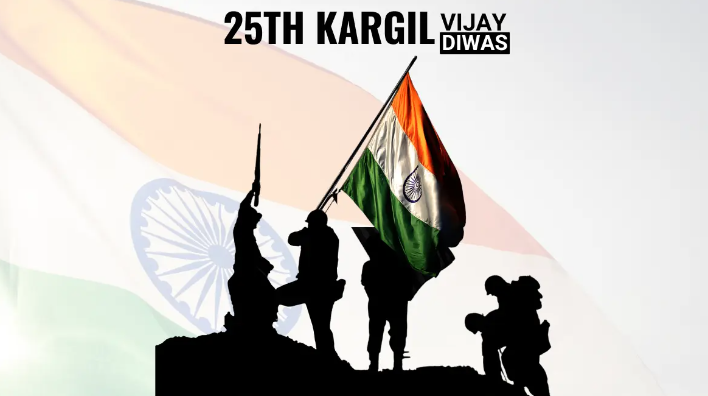Kargil Vijay Diwas: Commemorating Triumph and Bravery (GS Paper 1, Post-Independence Consolidation of India)

Introduction:
- Kargil Vijay Diwas, observed annually on July 26, stands as a solemn reminder of India's valor and sacrifice during one of its most challenging conflicts.
- This day marks the victory of the Indian armed forces in the Kargil War of 1999, a pivotal confrontation between India and Pakistan.
- Celebrated with deep reverence and pride, Kargil Vijay Diwas not only honors the bravery of Indian soldiers but also reflects on the broader impact of the conflict on India's military strategy and international relations.
Background of the Kargil War:
- The Kargil War was a significant military engagement that unfolded in the summer of 1999, making it the first conflict between two nuclear-armed states in South Asia.
- The war’s roots can be traced back to longstanding tensions between India and Pakistan, including the 1971 war that led to the creation of Bangladesh and the subsequent disputes over territories such as the Siachen Glacier.
- The nuclear tests conducted by both nations in 1998 further escalated these tensions, culminating in the Lahore Declaration of February 1999, which aimed to address the Kashmir conflict through peaceful dialogue.
- However, in the winter of 1998-1999, Pakistani forces covertly infiltrated the Kargil sector, establishing positions along the Line of Control (LOC) and launching a well-organized military operation.
- Initially mistaken by Indian troops as terrorist activities, the situation soon became clear that a full-scale military conflict was underway.
- The ensuing conflict, fought along a 170km stretch from Mashkoh Valley to Turtuk in the Kargil sector, saw India launching Operation Vijay to reclaim its territory.
Significance of Kargil Vijay Diwas:
- Kargil Vijay Diwas serves as a day of remembrance for the courage and sacrifice demonstrated by Indian soldiers during the Kargil War.
- Since 1999, this day has been dedicated to honoring the fallen heroes and celebrating the successful completion of Operation Vijay.
- The Kargil War Memorial in Dras, constructed in 2000 and renovated in 2014, stands as a testament to the bravery of the Indian forces.
- Additionally, the National War Memorial, inaugurated in 2019, commemorates soldiers from various conflicts, including Kargil.
Impact of the Kargil War:
- Global Recognition of the Line of Control (LoC): The war reinforced the LoC as the de facto border between India and Pakistan, with the international community largely accepting this status.
- Strengthened Strategic Partnerships: The conflict marked a turning point in Indo-US relations, showcasing India as a responsible nuclear power and leading to the Indo-US Nuclear Deal.
- Diplomatic Gains: The war exerted significant diplomatic pressure on Pakistan, isolating it internationally and resulting in strong criticism from global leaders.
- Highlighting Nuclear Diplomacy: The Kargil War brought global attention to the nuclear dynamics in South Asia, emphasizing the risks associated with regional conflicts between nuclear-armed states.
- Global Perception: India’s effective management of the conflict enhanced its global stature, showcasing its military capabilities and strategic resolve.
Operations Associated with the Kargil War:
- Operation Vijay: The primary military response aimed at clearing infiltrators and restoring the status quo along the LOC.
- Operation Safed Sagar: The Indian Air Force’s aerial operations supported ground troops, involving high-altitude flights and various aircraft.
- Operation Talwar: The Indian Navy's operation ensured maritime security and deterrence, signaling readiness for further aggression if needed.
Post-Kargil Reforms:
The Kargil War prompted significant reforms to enhance national security:
- Security Sector Reforms: The Kargil Review Committee (KRC) highlighted intelligence and management deficiencies, leading to increased transparency and major security reforms.
- Creation of the Chief of Defence Staff (CDS): Established to promote jointness among the three services and act as a single-point advisor to the government.
- Tri-Service Commands: Integration of Army, Navy, and Air Force resources, with the Andaman and Nicobar Command serving as a test-bed for future commands.
- Intelligence Reforms: Formation of the National Technical Research Organisation (NTRO) and Defence Intelligence Agency (DIA) to improve intelligence capabilities and coordination.
- Border Management Enhancements: Improved surveillance, patrolling, and technology for border security.
- Operational Reforms: Modernization of weapon systems and increased focus on high-altitude warfare training.
- Counter-Terrorism Measures: Strengthening of counter-terrorism capabilities and coordination among security agencies.
- Indigenous Satellite Navigation System: Development of the Indian Regional Navigation Satellite System (IRNSS) following denial of US satellite navigation data.
- Doctrinal Changes: Evolution of military doctrines, including the Cold Start Doctrine, to address multi-dimensional proxy wars.
Conclusion:
- The Kargil War was a defining moment for India, influencing its military strategies and national security policies profoundly.
- Kargil Vijay Diwas stands as a day of national pride, reflecting on the successes of Operation Vijay and the broader impacts of the conflict.
- The war underscored the importance of robust security measures and led to transformative reforms in India’s defense and intelligence sectors.
- The legacy of Kargil continues to shape India’s defense strategies and international relations, reinforcing its position as a rising power with a formidable military stance.


